Removal Procedure
Tools Required
Caution: Do not install this part if you can not completely refill the vehicle with CNG
after a repair. Failure to properly leak-check the system after the part
replacement may result in serious injury, death, or damage to the vehicle
or the part.
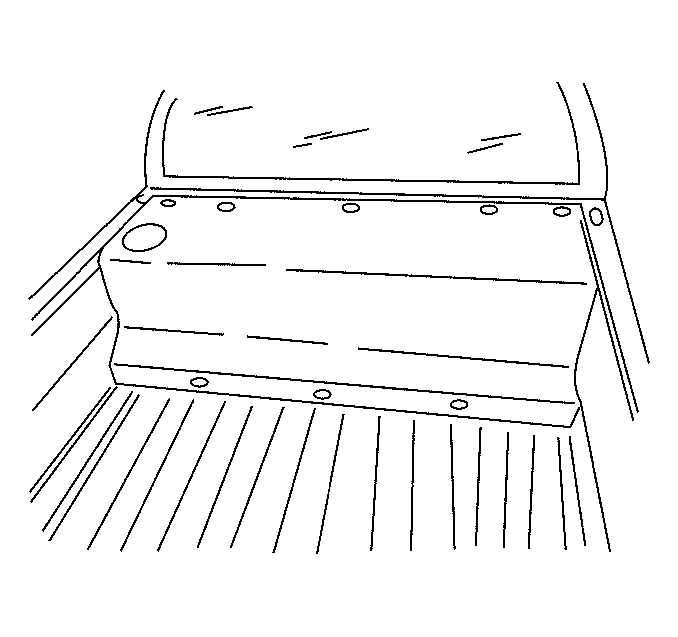
- Remove the fuel tank cover. Refer to
CNG Fuel Tank Cover Replacement
in the Body Rear End section of the Bi-Fuel
Supplement service manual.
- Relieve the CNG fuel system line pressure. Refer to
Fuel Pressure Relief
.
Caution: Always use the J 42435-B Compressed Natural Gas (CNG) Fuel Tank Venting Kit in conjunction with the General Motors approved Fuel Tank Venting service procedure to vent CNG fuel tanks. Failure
to use the J 42435-B and follow the approved Fuel Tank Venting procedure could result in death, serious injury or vehicle and component damage.
The J 42435-B is required for the following reasons:
| • | Natural gas fuel vapor can also contain water vapor. |
| • | The pressure drop associated with venting high pressure gaseous fuel can cause fuel vapor, tank and line temperatures to reach -73°C (-100°F) or colder. |
| • | The below freezing temperature can cause the water vapor to freeze |
| • | The J 42435-B vent hose contains an orifice which is intended to freeze before the CNG high pressure lock-off (HPL) tank valve freezes. |
| • | The J 42435-B pressure gauge can indicate a restricted orifice if fuel flow ceases. |
| • | Internal
fuel tank ice build-up may result when venting the CNG fuel tank without the J 42435-B. |
| - | Internal
fuel tank ice build-up can completely restrict the venting of fuel. |
| - | Venting may cease indefinitely depending upon ambient temperature conditions. |
| - | The ceasing of fuel tank venting may falsely indicate that the fuel tank pressure has been completely vented. |
| - | CNG fuel tanks with exceptionally high water content are suceptible to internal fuel tank ice build-up even with the use of the J 42435-B. |
- Venting natural gas is no longer audible from the vent stack.
- Close the J 42435-B ¼-turn valve and stabilize the fuel tank and line assembly at a temperature greater than 7°C (45°F) for at least 4 hours.
| | If the ambient temperature is less than 7°C (45°F), warm the fuel
tank and vent line assembly manually, either with warm water or by placing the tank and line assembly into a warm environment. |
- The J 42435-B pressure gauge indicates 0 kPa (0 psi).
- Vent the internal CNG fuel pressure from the tank. Refer to
Fuel Tank Venting
.
Caution: Unless directed otherwise, the ignition and start switch must be in the OFF or LOCK position, and all electrical loads must be OFF before servicing
any electrical component. Disconnect the negative battery cable to prevent an electrical spark should a tool or equipment come in contact with an exposed electrical terminal. Failure to follow these precautions may result in personal injury and/or damage to
the vehicle or its components.
- Disconnect the negative battery cable.
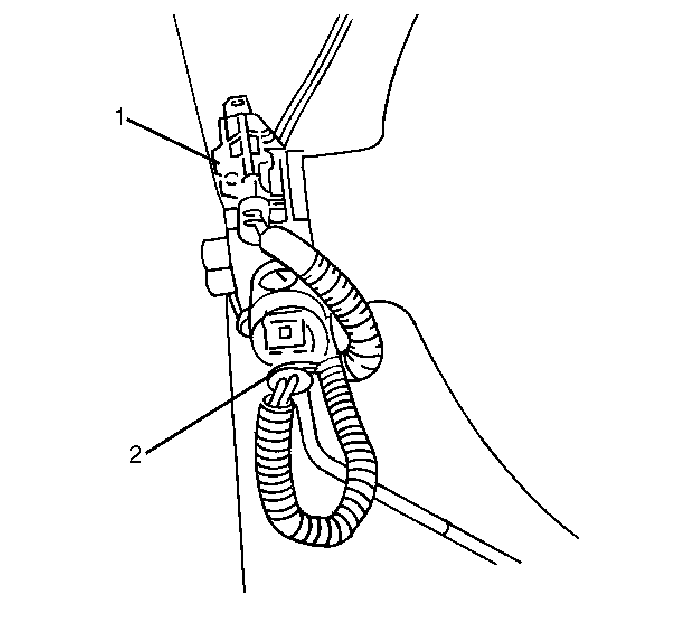
- Disconnect the following electrical connectors:
| • | High pressure lock-off (HPL) (1) |
| • | Fuel sending unit (FSU) (2) |

- Using the
J 43602
HPL Crowfoot removal tool, loosen the HPL.
- Mark the tank in two places approximately 180 degrees apart for tank re-installment reference.

- Remove the upper mounting bracket nuts and bolts and retain them.
- Remove the clevis and bridge pins.
- Remove the upper mounting brackets.
- Use the
J 45529
CNG Tank Sling and a lifting device in order to remove the tank from the vehicle enough to allow removal of the HPL from the tank.
- Unscrew and remove the HPL and the O-ring from the tank.
Installation Procedure
Tools Required
- Install a NEW O-ring on the HPL.
- Lubricate the O-ring with petroleum jelly.
- Install the HPL in the tank and tighten hand-tight.
- Lower the tank onto the lower mounting brackets using a lifting device and the
J 45529
CNG Tank Sling.
- Roll the tank to the proper position using the orientation marks.
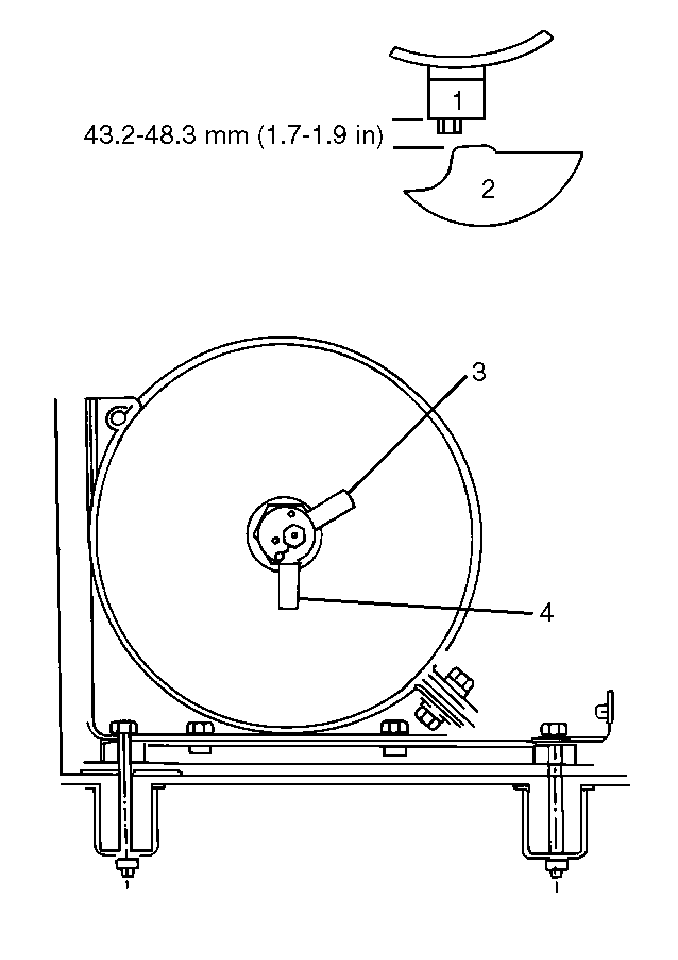
- Verify that the distance between the tank (1) and the pickup box (2) is within specification.
- Verify that the FSU (3) is positioned as shown.

- Install the upper mounting brackets.
Important:
| • | Verify that the bridge pins do not contact the CNG fuel tank. |
| • | Verify that the rubber isolators are correctly positioned before tightening the upper mounting bracket fasteners. |
- Install the bridge pins and clevis pins to the upper mounting brackets.
- Install the OLD mounting bracket nuts and bolts.
Tighten
Tighten the OLD mounting bracket nuts to 47 N·m (35 lb ft).
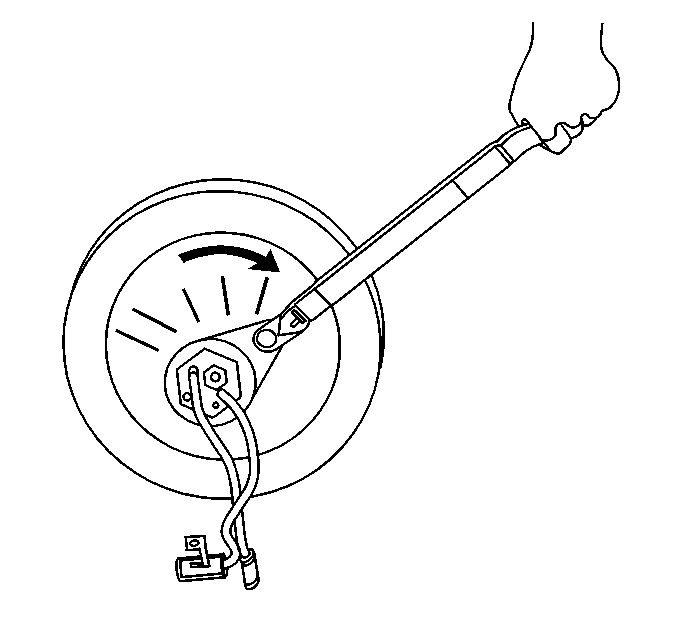
- Tighten the HPL as specified below.
Tighten
Tighten the HPL to a nominal torque of 305 N·m (225 ft lb) at 0 degree. Refer to the formula below for compensation of your torque wrench.
Important: Ensure the
J 43602
HPL Crowfoot removal tool is straight (0 degree) on the torque wrench.
- To obtain your Dial reading perform the following:
| • | Multiply your torque wrench length in inches by 305 (225)¹. |
| • | Add three to the length of your torque wrench². |
| • | Divide the first value¹ obtained by the second value² obtained. The result³ will indicate the amount of torque your wrench should tighten the HPL to. |
| • | For example if your wrench were 18 inches long: |
| • | 5490¹ divided by 21² = 261.4³. |
| • | You would tighten the HPL to 261.4N·m. |

- Remove the OLD mounting bracket nuts and bolts and discard them.

- Verify that the distance between the tank (1) and the pickup box (2) is within specification.
- Verify that the FSU (3) is positioned as shown.

- Install NEW mounting bracket bolts and nuts.
Tighten
Tighten the mounting bracket nuts to 47 N·m(35 lb ft).
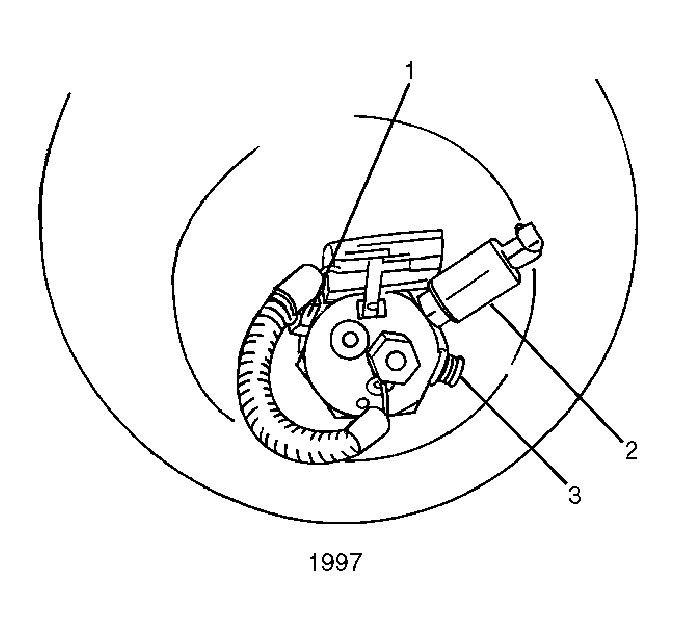
- Install the fuel outlet fitting (3) into the HPL using a NEW O-ring. Lubricate the O-ring with petroleum jelly.
Tighten
Tighten the fitting to 27 N·m (20 lb ft).
- Install the fuel inlet fitting (1) into the HPL using a NEW O-ring. Lubricate the O-ring with petroleum jelly.
Tighten
Tighten the fitting to 48 N·m (35 lb ft).
- Install the FSU (2) into the HPL using a NEW O-ring. Lubricate the O-ring with petroleum jelly.
Tighten
Tighten the fitting to 27 N·m (20 lb ft).
- Connect the fuel line to the outlet fitting (3) and the fill line to the inlet fitting (1) using NEW O-ring face seals. Lubricate the O-rings with petroleum jelly.
Tighten
Tighten the fuel line fitting (3) to 24 N·m (18 lb ft).
Tighten
Tighten the fill line fitting (1) to 37 N·m (27 lb ft).

- Connect the following connectors:
| • | High pressure lock-off (HPL) (1) |
| • | Fuel sending unit (FSU) (2) |
Caution: The high pressure lock-off solenoid seal is more likely
to leak at a lower fuel pressure. Always perform the fuel leak procedure exactly
as specified. Failure to follow the proper procedures may result in serious
injury or damage to the vehicle or part.
- Fuel the vehicle in three stages at the following pressures:
- Using the
J 41416
Ultrasonic Leak Detector inspect for fuel leaks at the HPL at EACH pressure.
- Connect the negative battery cable.
- Start and operate the engine on CNG.
- Inspect for fuel leaks at each serviced fitting using the
J 41416
.
- Attach the information label supplied with the replacement HPL in a visible location on the head of the tank.
- Install the tank cover. Refer to
CNG Fuel Tank Cover Replacement
in Body Rear End.












